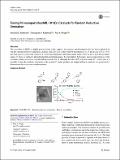Files in this item
Tuning Pd-nanoparticle@MIL-101(Cr) catalysts for tandem reductive amination
Item metadata
| dc.contributor.author | Anderson, Amanda E. | |
| dc.contributor.author | Baddeley, Christopher J. | |
| dc.contributor.author | Wright, Paul A. | |
| dc.date.accessioned | 2017-11-30T13:30:05Z | |
| dc.date.available | 2017-11-30T13:30:05Z | |
| dc.date.issued | 2017-11-27 | |
| dc.identifier | 251447280 | |
| dc.identifier | 7e33ce4d-b71c-4d21-a3bc-5e729a57ddc9 | |
| dc.identifier | 85035134902 | |
| dc.identifier | 000419901300017 | |
| dc.identifier.citation | Anderson , A E , Baddeley , C J & Wright , P A 2017 , ' Tuning Pd-nanoparticle@MIL-101(Cr) catalysts for tandem reductive amination ' , Catalysis Letters , vol. In press . https://doi.org/10.1007/s10562-017-2208-0 | en |
| dc.identifier.issn | 1011-372X | |
| dc.identifier.other | ORCID: /0000-0001-9750-6494/work/57330774 | |
| dc.identifier.other | ORCID: /0000-0002-4243-9957/work/62668254 | |
| dc.identifier.uri | https://hdl.handle.net/10023/12204 | |
| dc.description | The authors thank the EPSRC (EP/L505079/1), SASOL Technology UK and the University of St Andrews for funding. | en |
| dc.description.abstract | The versatility of MOFs as highly porous Lewis acidic supports for precious metal nanoparticles has been exploited for one-pot tandem reductive amination catalysis. MIL-101(Cr) loaded with Pd nanoparticles ca. 3 nm in size at 0.2–1 wt% has been used to catalyse the reaction of 4′-fluoroacetophenone with benzylamine under 10 bar of H2 to give the secondary amine, 4′-fluoro-α-methyl-N-phenylmethylbenzenemethanamine. For the highest Pd loading, major hydrogenolysis of the secondary amine occurs in a second tandem reaction, but by changing the ratio of Pd to Lewis acidic Cr3+ active sites it is possible to tune the catalytic selectivity to the desired 2° amine product. An empirical kinetic analysis was performed to demonstrate this active site complementarity. | |
| dc.format.extent | 1410095 | |
| dc.language.iso | eng | |
| dc.relation.ispartof | Catalysis Letters | en |
| dc.subject | Pd@MIL-101 | en |
| dc.subject | Tandem reductive amination | en |
| dc.subject | Kinetic modelling | en |
| dc.subject | QD Chemistry | en |
| dc.subject | DAS | en |
| dc.subject.lcc | QD | en |
| dc.title | Tuning Pd-nanoparticle@MIL-101(Cr) catalysts for tandem reductive amination | en |
| dc.type | Journal article | en |
| dc.contributor.institution | University of St Andrews. School of Chemistry | en |
| dc.contributor.institution | University of St Andrews. EaSTCHEM | en |
| dc.identifier.doi | 10.1007/s10562-017-2208-0 | |
| dc.description.status | Peer reviewed | en |
| dc.identifier.url | https://link.springer.com/article/10.1007%2Fs10562-017-2208-0#SupplementaryMaterial | en |
This item appears in the following Collection(s)
Items in the St Andrews Research Repository are protected by copyright, with all rights reserved, unless otherwise indicated.

